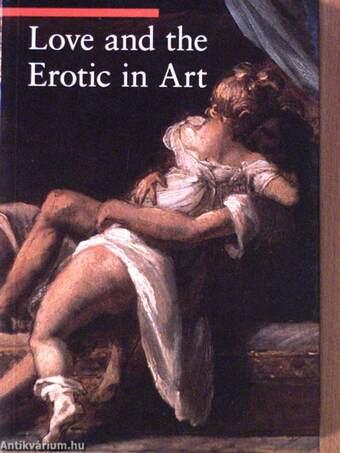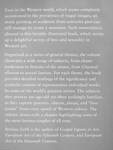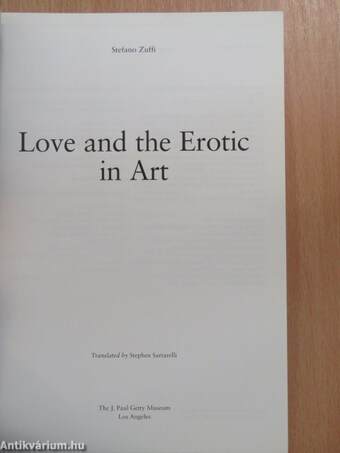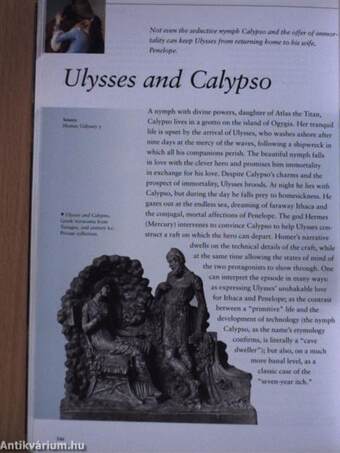1.067.327
kiadvánnyal nyújtjuk Magyarország legnagyobb antikvár könyv-kínálatát

VISSZA
A TETEJÉRE
JAVASLATOKÉszre-
vételek
Love and the Erotic in Art
| Kiadó: | Getty Publications |
|---|---|
| Kiadás helye: | Los Angeles |
| Kiadás éve: | |
| Kötés típusa: | Fűzött papírkötés |
| Oldalszám: | 383 oldal |
| Sorozatcím: | |
| Kötetszám: | |
| Nyelv: | Angol |
| Méret: | 20 cm x 14 cm |
| ISBN: | 978-1-60606-009-4 |
| Megjegyzés: | Színes fotókkal gazdagon illusztrálva. |
naponta értesítjük a beérkező friss
kiadványokról
naponta értesítjük a beérkező friss
kiadványokról
Fülszöveg
Even in the Western world, which seems completely
accustomed to the prevalence of risqué images, an
erotic painting or sculpture from centuries past can
still manage to create a sensation. Such masterpieces
abound in this lavishly illustrated book, which serves
up a delightful survey of love and sexuality in
Western art.
Organized as a series of general themes, the volume
illustrates a wide range of subjects, from chaste
tenderness to frenzies of the senses, from Classical
allusion to sexual fantasy. For each theme, the book
provides detailed readings of the significance and
symbolic content of representative individual works
by some of the world's greatest artists. The subjects
they portray are age-old yet often strikingly familiar,
as they capture gestures, objects, places, and "love
scenes" from every epoch of Western culture. The
volume closes with a chapter highlighting some of
the most famous couples of all time.
Stefano Zuffi is the author of Gospel... Tovább
Fülszöveg
Even in the Western world, which seems completely
accustomed to the prevalence of risqué images, an
erotic painting or sculpture from centuries past can
still manage to create a sensation. Such masterpieces
abound in this lavishly illustrated book, which serves
up a delightful survey of love and sexuality in
Western art.
Organized as a series of general themes, the volume
illustrates a wide range of subjects, from chaste
tenderness to frenzies of the senses, from Classical
allusion to sexual fantasy. For each theme, the book
provides detailed readings of the significance and
symbolic content of representative individual works
by some of the world's greatest artists. The subjects
they portray are age-old yet often strikingly familiar,
as they capture gestures, objects, places, and "love
scenes" from every epoch of Western culture. The
volume closes with a chapter highlighting some of
the most famous couples of all time.
Stefano Zuffi is the author of Gospel Figures in Art,
European Art of the Fifteenth Century, and European
Art of the Sixteenth Century. Vissza
Témakörök
- Idegennyelv > Idegennyelvű könyvek > Angol > Művészetek > Művészettörténet, általános
- Idegennyelv > Idegennyelvű könyvek > Angol > Szex, szerelem
- Művészetek > Művészettörténet általános > Társadalom és művészet > Egyéb
- Művészetek > Művészettörténet általános > Idegen nyelv > Angol
- Művészetek > Művészettörténet általános > Művészettörténet > Külföldi
- Szex, szerelem > Szex, szerelem a művészetekben > Egyéb
- Szex, szerelem > Kultúrtörténet > Nyugati kultúrkör
- Szex, szerelem > Idegennyelvű
- Erotika > Erotikus művészet > Egyéb
- Erotika > Kultúrtörténet > Nyugati kultúrkör
- Idegennyelv > Idegennyelvű könyvek > Angol
Stefano Zuffi
Stefano Zuffi műveinek az Antikvarium.hu-n kapható vagy előjegyezhető listáját itt tekintheti meg: Stefano Zuffi könyvek, művekMegvásárolható példányok
Nincs megvásárolható példány
A könyv összes megrendelhető példánya elfogyott. Ha kívánja, előjegyezheti a könyvet, és amint a könyv egy újabb példánya elérhető lesz, értesítjük.









